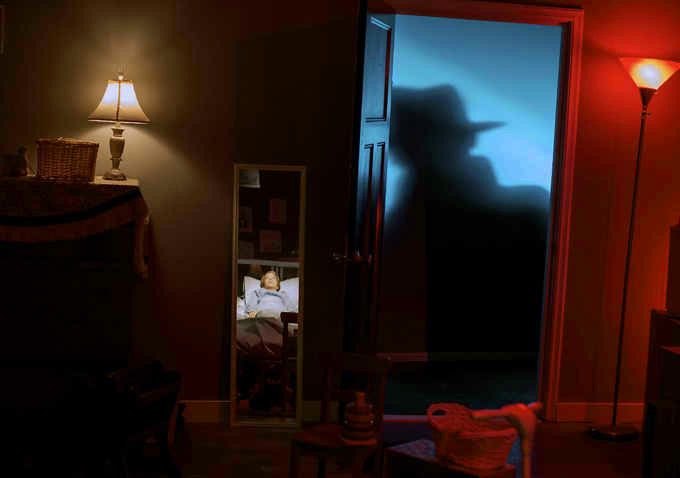 The frightening netherworld of night terrors and sleep paralysis sounds utterly terrifying just in description alone; people trapped in awakened states of semi-consciousness, unable to move, but capable of witnessing some truly horrific hallucinations that seem all too real. Or are they real? Are these nightmarish horrors a manifestation of something supernatural? A chemical imbalance triggered by stress or one’s lifestyle? A sleep disorder based on the anxieties of the human subconscious? All of this is explored, but not much of it illuminated in any meaningful way in Rodney Ascher’s docudrama “The Nightmare.” Ascher’s follow-up to the critically acclaimed “Room 237” that gave wacko conspiracy theorists plenty of room to wax about their idiotic, totally-off-base hypotheses about Stanley Kubrick’s “The Shining,” his latest doc takes a creepy and creative approach to the malady of sleep paralysis and its devastating aftereffects.
The frightening netherworld of night terrors and sleep paralysis sounds utterly terrifying just in description alone; people trapped in awakened states of semi-consciousness, unable to move, but capable of witnessing some truly horrific hallucinations that seem all too real. Or are they real? Are these nightmarish horrors a manifestation of something supernatural? A chemical imbalance triggered by stress or one’s lifestyle? A sleep disorder based on the anxieties of the human subconscious? All of this is explored, but not much of it illuminated in any meaningful way in Rodney Ascher’s docudrama “The Nightmare.” Ascher’s follow-up to the critically acclaimed “Room 237” that gave wacko conspiracy theorists plenty of room to wax about their idiotic, totally-off-base hypotheses about Stanley Kubrick’s “The Shining,” his latest doc takes a creepy and creative approach to the malady of sleep paralysis and its devastating aftereffects.
Studying eight different subjects, mostly from the United States, all suffering from the results of this nocturnal psychosis, Ascher recreates the victims’ unholy evening terrors as they describe in deep, horrific details what haunts their dreams. Most of the nightmares are strangely similar, a flickering electrical current flowing through the body announcing the onset of a dreadful fever dream, and black, shadowy figures entering the bedroom petrifying the restless as they lay cogent in their incarcerated body watching pure evil take menacing steps closer and closer. Sometimes there’s a black-hatted shadow presence with ruby red demonic eyes. Other times it’s a black cat laying on the victim. There’s even one man who is visited by two made-of-static alien figures right out of the movies, who has been haunted by these extra terrestrials since he was a kid (one has to wonder if this trauma was simply anxious parents hovering over their kid as he slept for too many successive years).
As each somnambulist recalls what he or she undergoes each night, Ascher recreates these not-so-off-to-sleep scenarios with scary detail and surreal reproductions in a TV studio-esque laboratory. There is much throbbing fear and dread expressed in this simulations, some that many may find all too real (apparently an audience member broke down at Sundance, confessing she, too, suffered from this disorder). And while sometimes delightfully scary or genuinely disturbing, “The Nightmare” doesn’t really go anywhere with its examination other than anxiety-inducing presentations of each sleep subject’s interrogations.

But these replications quickly get old. The too-many jump scares becomes a tired technique, and given that so many of the fear-provoking experiences are alike, you can only show so many stalking wraiths, inhospitable Babadooks, and demonically-lit filters before you need to try something else. Ascher’s film really doesn’t even make the attempt. Maddeningly, while there are many parallel corollaries, “The Nightmare” never really explains why, other than to express: “isn’t it peculiar how many of these people witnessed the same thing? Hmmmm.” And as for any medical, scientific or psychological explanations for the traumatizing recurrences, it’s as if Ascher set an experiment with none of the basic fundamental follow-throughs to come up with some kind of thesis.
The consequences of this evidently-mysterious disorder, as recounted in the testimonials, are chilling: anxiety, trauma, suicidal thoughts, and more, and one subject becomes a Christian when she found faith to be a strong deterrent to the “evil” forces that were haunting her. Problematically, “The Nightmare” is much more interested in illustrating terrors than it is in explaining or enlightening them. And so Ascher’s film is largely one-note and essentially exploits these various narratives with the sole purpose of keeping the viewer in a constant state of alarm and stress.
But that, to be frank, is kind of bogus. “The Nightmare” can be deeply distressing and blood-curdling, and it can be a little silly, too. Ultimately, as a slight investigation into the syndrome of distressed somnambulism, these poor souls still suffering probably deserve a little bit better. [C+]
This is a reprint of our review from the 2015 Sundance Film Festival.

